2010 KIA Sportage warning light
[x] Cancel search: warning lightPage 46 of 371

337
Knowing your vehicle
1
2
3
4
5
6
7
8
9
Safety belt warning light and
chime
If the driver's safety belt is not fas-
tened when the key is turned ON or
if it is unfastened after the key is
turned ON, the safety belt warning
light blinks until the belt fastened.
If the driver's safety belt is not fas-
tened when the key is turned ON or
if it is unfastened after the key is ON,
the safety belt warning chime will
sound for approximately 6 seconds.
At this time, if the safety belt is fas-
tened, the chime will stop at once.
Lap/shoulder belt
To fasten the front lap/shoulderbelt:
1. Grasp the buckle and tongue plate.
2. Slowly pull the lap/shoulder belt out from the retractor. 3. Insert the tongue plate (
➀) into the
open end of the buckle (
➁) until an
audible “click” is heard, indicating
the belt is locked in the buckle.
1GQA20831GHA22621GHA2263
Page 54 of 371
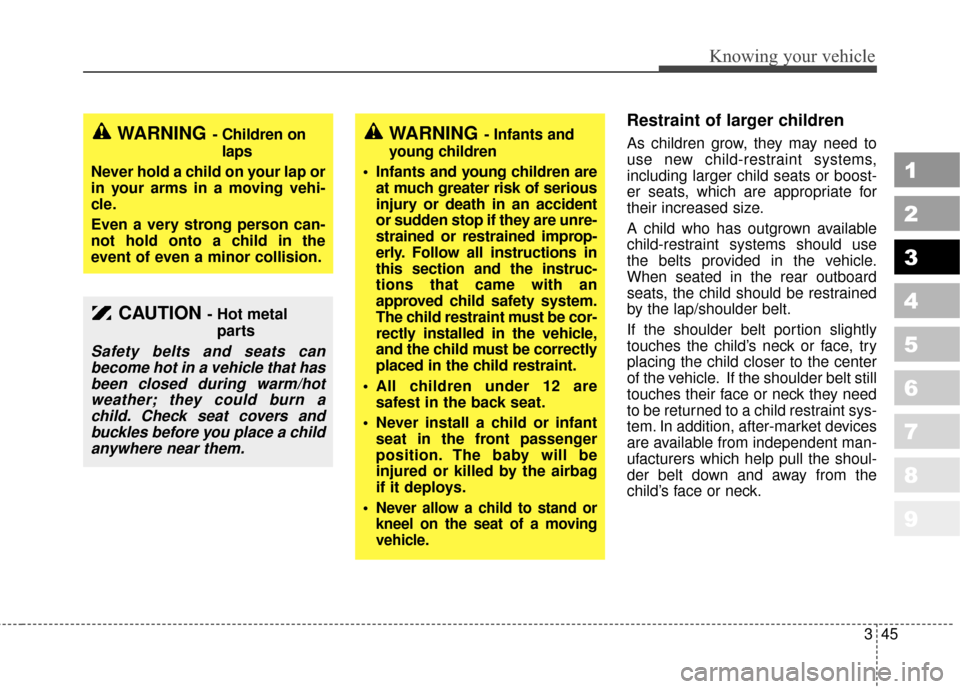
345
Knowing your vehicle
1
2
3
4
5
6
7
8
9
Restraint of larger children
As children grow, they may need to
use new child-restraint systems,
including larger child seats or boost-
er seats, which are appropriate for
their increased size.
A child who has outgrown available
child-restraint systems should use
the belts provided in the vehicle.
When seated in the rear outboard
seats, the child should be restrained
by the lap/shoulder belt.
If the shoulder belt portion slightly
touches the child’s neck or face, try
placing the child closer to the center
of the vehicle. If the shoulder belt still
touches their face or neck they need
to be returned to a child restraint sys-
tem. In addition, after-market devices
are available from independent man-
ufacturers which help pull the shoul-
der belt down and away from the
child’s face or neck.WARNING- Infants and
young children
Infants and young children are at much greater risk of serious
injury or death in an accident
or sudden stop if they are unre-
strained or restrained improp-
erly. Follow all instructions in
this section and the instruc-
tions that came with an
approved child safety system.
The child restraint must be cor-
rectly installed in the vehicle,
and the child must be correctly
placed in the child restraint.
All children under 12 are safest in the back seat.
Never install a child or infant seat in the front passenger
position. The baby will be
injured or killed by the airbag
if it deploys.
Never allow a child to stand or
kneel on the seat of a moving
vehicle.
WARNING- Children on laps
Never hold a child on your lap or
in your arms in a moving vehi-
cle.
Even a very strong person can-
not hold onto a child in the
event of even a minor collision.
CAUTION - Hot metal parts
Safety belts and seats canbecome hot in a vehicle that hasbeen closed during warm/hotweather; they could burn achild. Check seat covers andbuckles before you place a childanywhere near them.
Page 65 of 371
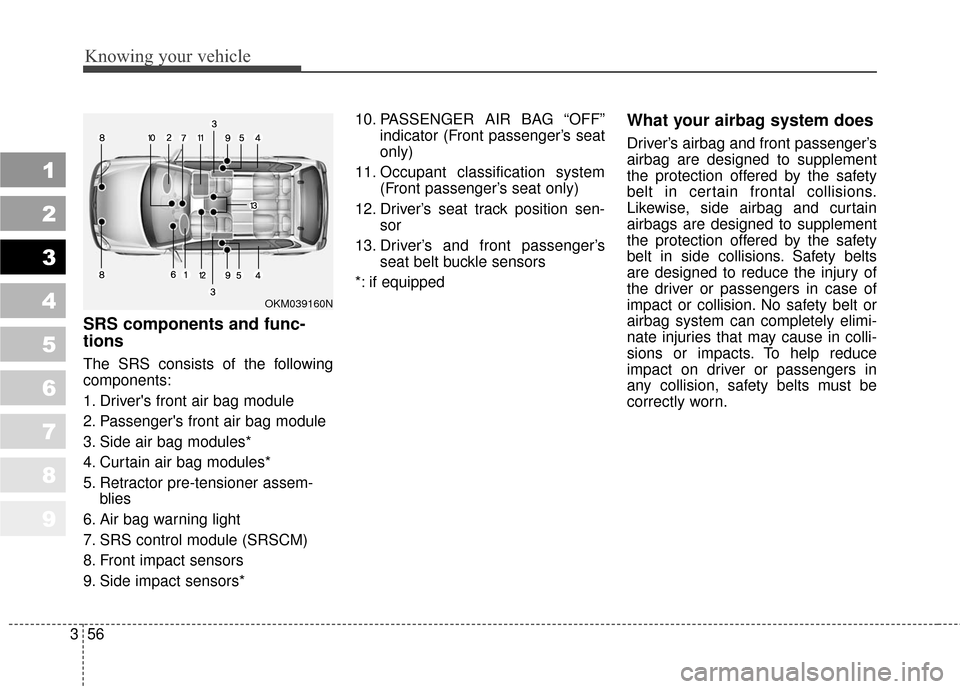
Knowing your vehicle
56
3
1
2
3
4
5
6
7
8
9
SRS components and func-
tions
The SRS consists of the following
components:
1. Driver's front air bag module
2. Passenger's front air bag module
3. Side air bag modules*
4. Curtain air bag modules*
5. Retractor pre-tensioner assem-
blies
6. Air bag warning light
7. SRS control module (SRSCM)
8. Front impact sensors
9. Side impact sensors* 10. PASSENGER AIR BAG “OFF”
indicator (Front passenger’s seat
only)
11. Occupant classification system (Front passenger’s seat only)
12. Driver’s seat track position sen- sor
13. Driver’s and front passenger’s seat belt buckle sensors
*: if equipped
What your airbag system does
Driver’s airbag and front passenger’s
airbag are designed to supplement
the protection offered by the safety
belt in certain frontal collisions.
Likewise, side airbag and curtain
airbags are designed to supplement
the protection offered by the safety
belt in side collisions. Safety belts
are designed to reduce the injury of
the driver or passengers in case of
impact or collision. No safety belt or
airbag system can completely elimi-
nate injuries that may cause in colli-
sions or impacts. To help reduce
impact on driver or passengers in
any collision, safety belts must be
correctly worn.
OKM039160N
Page 68 of 371
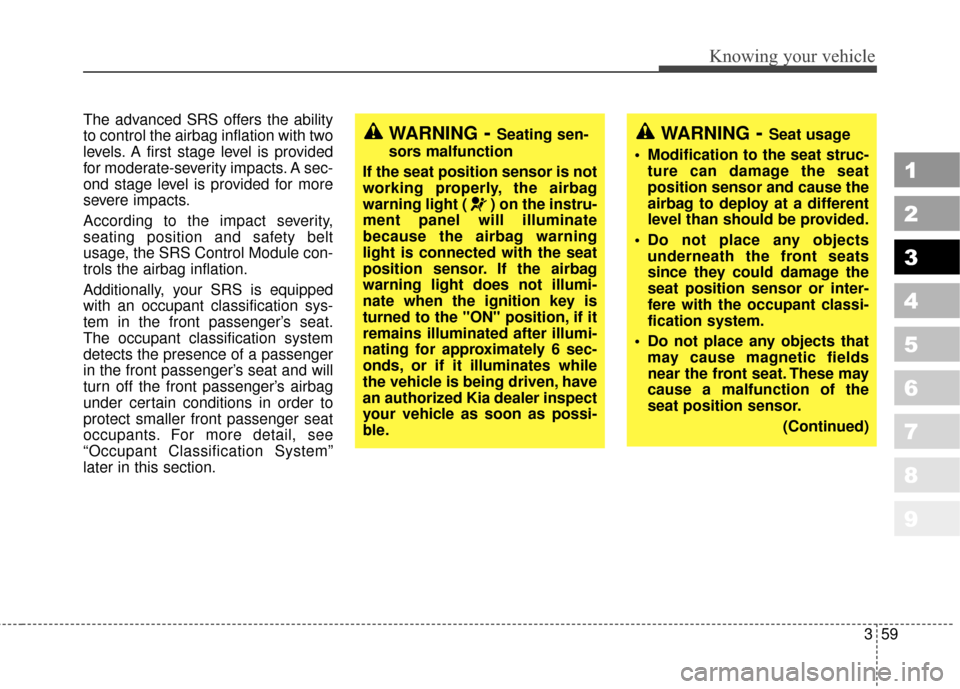
359
1
2
3
4
5
6
7
8
9
Knowing your vehicle
The advanced SRS offers the ability
to control the airbag inflation with two
levels. A first stage level is provided
for moderate-severity impacts. A sec-
ond stage level is provided for more
severe impacts.
According to the impact severity,
seating position and safety belt
usage, the SRS Control Module con-
trols the airbag inflation.
Additionally, your SRS is equipped
with an occupant classification sys-
tem in the front passenger’s seat.
The occupant classification system
detects the presence of a passenger
in the front passenger’s seat and will
turn off the front passenger’s airbag
under certain conditions in order to
protect smaller front passenger seat
occupants. For more detail, see
“Occupant Classification System”
later in this section.WARNING- Seating sen-
sors malfunction
If the seat position sensor is not
working properly, the airbag
warning light ( ) on the instru-
ment panel will illuminate
because the airbag warning
light is connected with the seat
position sensor. If the airbag
warning light does not illumi-
nate when the ignition key is
turned to the "ON" position, if it
remains illuminated after illumi-
nating for approximately 6 sec-
onds, or if it illuminates while
the vehicle is being driven, have
an authorized Kia dealer inspect
your vehicle as soon as possi-
ble.WARNING- Seat usage
Modification to the seat struc- ture can damage the seat
position sensor and cause the
airbag to deploy at a different
level than should be provided.
Do not place any objects underneath the front seats
since they could damage the
seat position sensor or inter-
fere with the occupant classi-
fication system.
Do not place any objects that may cause magnetic fields
near the front seat. These may
cause a malfunction of the
seat position sensor.
(Continued)
Page 69 of 371

Knowing your vehicle
60
3
1
2
3
4
5
6
7
8
9
Driver’s airbag
Your vehicle is equipped with an
Advanced Supplemental Restraint
(Air Bag) System and lap/shoulder
belts at both the driver and passen-
ger seating positions.
The driver’s airbag is stored in the
center of the steering wheel.
(Continued)
Have your car checked by a
Kia dealer as soon as possible
if the SRS warning light
comes on. Ignoring the indica-
tor light can result in serious
or fatal injury.
Sitting improperly or out of position can provide incorrect
data to the occupant classifi-
cation system and result in
serious or fatal injury in a
crash. All occupants should
sit upright in their seats with
their feet on the floor.WARNING- Steering
wheel
You must always sit as far back from the steering wheel
airbag as possible (chest at
least 250 mm (10 inches) away
from the steering wheel), while
still maintaining a comfortable
seating position for good
vehicle control, in order to
reduce the risk of injury or
death in a collision.
Never place objects over the airbag storage compartments
or between the airbags and
yourself. Due to the speed and
force of the airbag inflation,
such objects could hit your
body at high speed and cause
severe bodily injury and even
death.
Do not put stickers or orna- ments on the steering wheel
cover. These may interfere
with the deployment of the
airbag.
HLZ2120
OKM039056
Page 71 of 371

Knowing your vehicle
62
3
1
2
3
4
5
6
7
8
9
Main components of occupant
classification system
A detection device located within
the front passenger seat track.
Electronic system to determine whether passenger air bag sys-
tems (both front and side) should
be activated or deactivated.
A warning light located on the instrument panel which illuminates
the words PASSENGER AIR BAG
“OFF” indicating the front passen-
ger air bag system is deactivated.
The instrument panel air bag warn- ing light is interconnected with the
occupant classification system. Always be sure that you and all vehi-
cle occupants are seated and
restrained properly (sitting upright
with the seat in an upright position,
centered on the seat cushion, with
the person’s legs comfortably
extended, feet on the floor, and wear-
ing the safety belt properly) for the
most effective protection by the air
bag and the safety belt.
The OCS (Occupant Classification
System) may not function properly
if the passenger takes actions
which can defeat the detection sys-
tem. These include:
(1) Failing to sit in an upright posi- tion.
(2) Leaning against the door or cen- ter console.
(3) Sitting towards the sides or the front of the seat.
(4) Putting legs on the dashboard or resting them on other locations
which reduce the passenger
weight on the front seat.
(5) Improperly wearing the safety
belt.
(6) Reclining the seat back. The PASSENGER AIR BAG “OFF”
indicator illuminates after the igni-
tion key is turned to the “ON” posi-
tion or after the engine is started. If
the front passenger’s seat is occu-
pied by very small person, the
PASSENGER AIR BAG “OFF” indi-
cator will remain illuminated. If the
front passenger’s seat is occupied
by a person of adult size, the PAS-
SENGER AIR BAG “OFF” indicator
will turn off after 4 seconds.
If the front passenger's seat is unoccupied, the PASSENGER AIR
BAG “OFF” indicator will turn on,
and the front passenger's airbag
will not deploy in frontal crashes.
If the PASSENGER AIR BAG “OFF” indicator illuminates, the
front passenger’s airbag will not
deploy in frontal crashes.
If the front passenger’s seat is occupied by a person of adult size,
the PASSENGER AIR BAG “OFF”
indicator is not illuminated and the
front passenger’s airbag will deploy
in frontal crashes.
Page 72 of 371
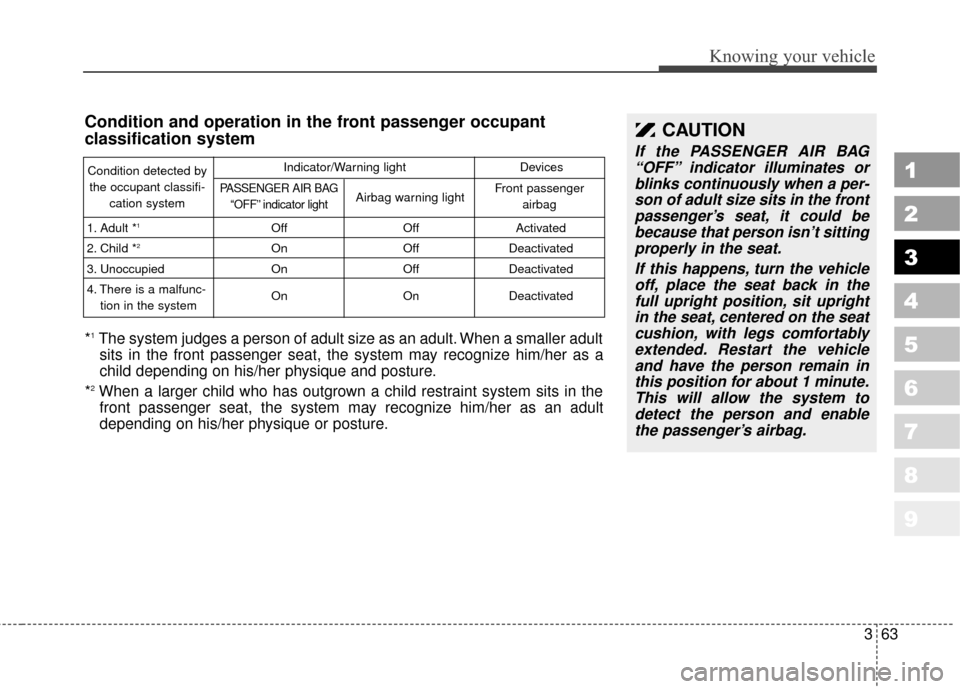
363
1
2
3
4
5
6
7
8
9
Knowing your vehicle
CAUTION
If the PASSENGER AIR BAG“OFF” indicator illuminates orblinks continuously when a per-son of adult size sits in the frontpassenger’s seat, it could bebecause that person isn’t sittingproperly in the seat.
If this happens, turn the vehicleoff, place the seat back in thefull upright position, sit uprightin the seat, centered on the seatcushion, with legs comfortablyextended. Restart the vehicleand have the person remain inthis position for about 1 minute.This will allow the system todetect the person and enablethe passenger’s airbag.
Condition and operation in the front passenger occupant
classification system
Condition detected by
the occupant classifi- cation system
1. Adult *
1
2. Child *2
3. Unoccupied
4. There is a malfunc- tion in the system Off
On
On
On Off
Off
Off
On Activated
Deactivated
Deactivated
Deactivated
PASSENGER AIR BAG “OFF” indicator lightAirbag warning light Front passenger
airbag
Indicator/Warning light Devices
*1The system judges a person of adult size as an adult. When a smaller adult
sits in the front passenger seat, the system may recognize him/her as a
child depending on his/her physique and posture.
*
2When a larger child who has outgrown a child restraint system sits in the front passenger seat, the system may recognize him/her as an adult
depending on his/her physique or posture.
Page 73 of 371
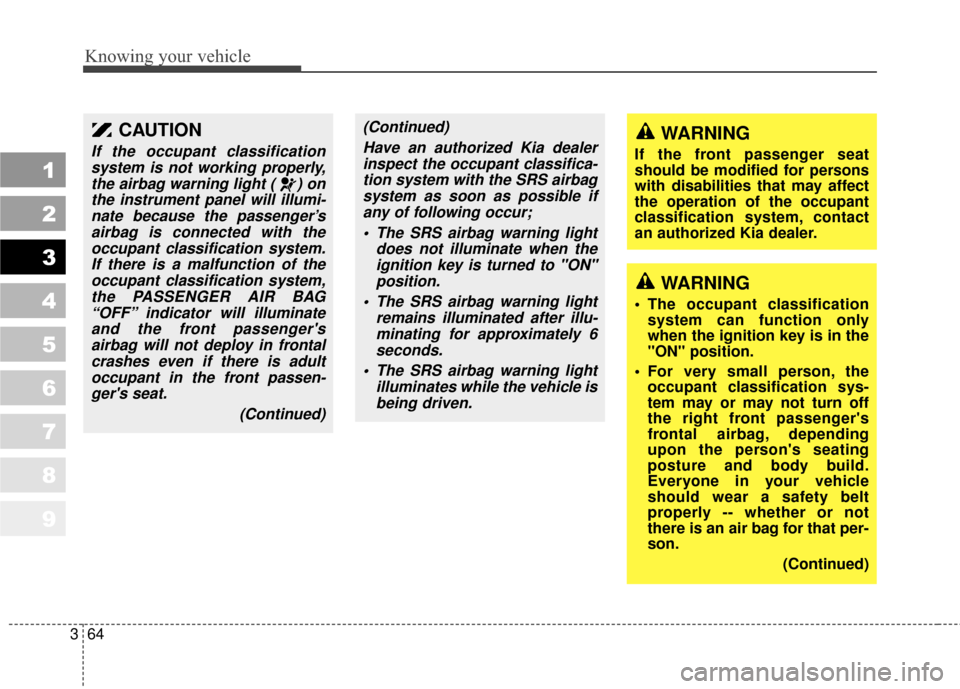
Knowing your vehicle
64
3
1
2
3
4
5
6
7
8
9
CAUTION
If the occupant classification
system is not working properly,the airbag warning light ( ) onthe instrument panel will illumi-nate because the passenger’sairbag is connected with theoccupant classification system.If there is a malfunction of theoccupant classification system,the PASSENGER AIR BAG“OFF” indicator will illuminateand the front passenger'sairbag will not deploy in frontalcrashes even if there is adultoccupant in the front passen-ger's seat.
(Continued)
(Continued)Have an authorized Kia dealerinspect the occupant classifica-tion system with the SRS airbagsystem as soon as possible ifany of following occur;
The SRS airbag warning light does not illuminate when theignition key is turned to "ON"position.
The SRS airbag warning light remains illuminated after illu-minating for approximately 6seconds.
The SRS airbag warning light illuminates while the vehicle isbeing driven.
WARNING
The occupant classification system can function only
when the ignition key is in the
"ON" position.
For very small person, the occupant classification sys-
tem may or may not turn off
the right front passenger's
frontal airbag, depending
upon the person's seating
posture and body build.
Everyone in your vehicle
should wear a safety belt
properly -- whether or not
there is an air bag for that per-
son.
(Continued)
WARNING
If the front passenger seat
should be modified for persons
with disabilities that may affect
the operation of the occupant
classification system, contact
an authorized Kia dealer.